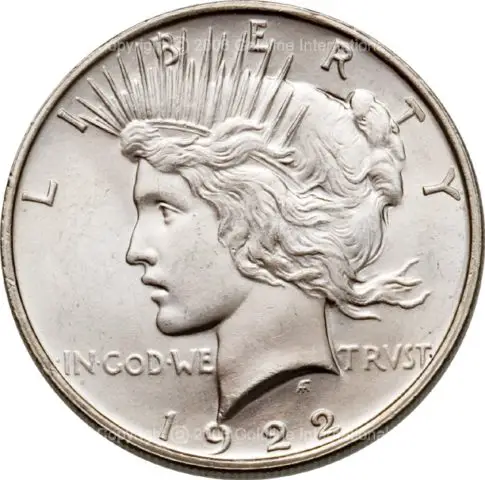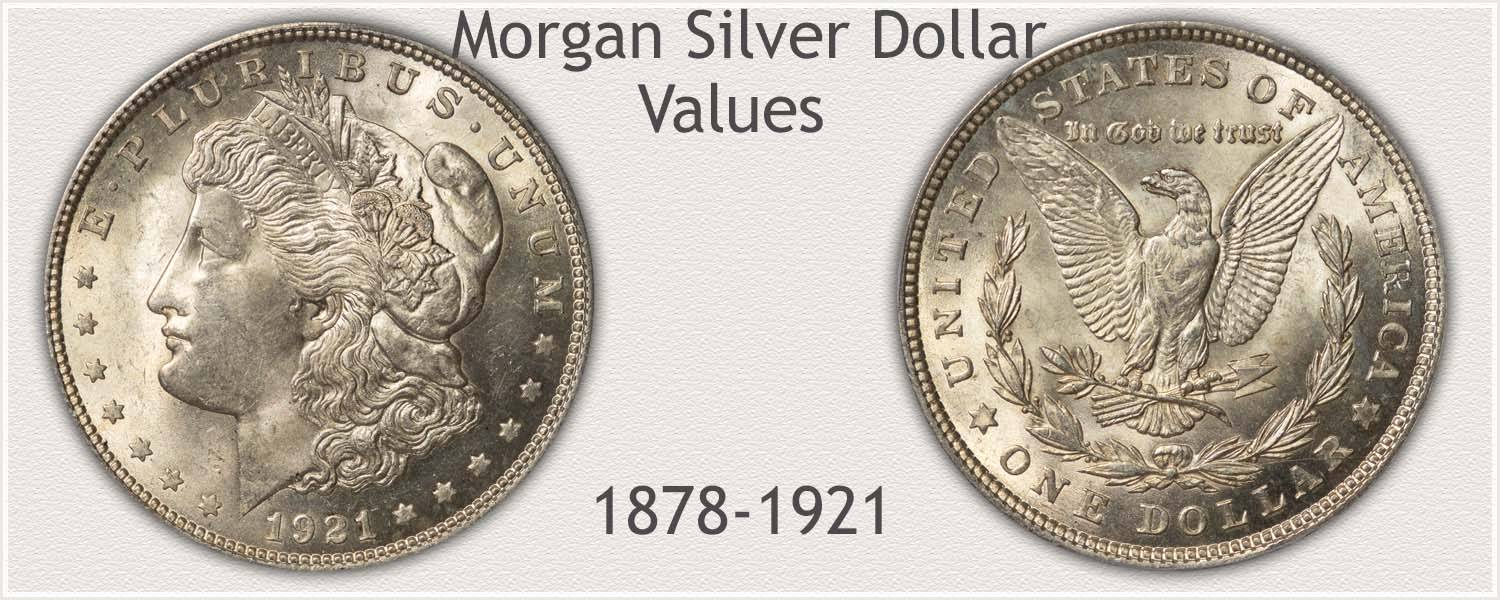Morgan Dollar Value
Morgan Dollars are among the most popular of all United States coinage. The series was introduced in 1878 and minted continuously until 1904, and again in 1921. The coins were generally struck in large quantities at a total of five different nationwide Mints. Whereas most issues of the series are readily available, there are some issues with low mintages or which saw heavy circulation. These mintage and condition rarities are highly sought by collectors. Some coins also display proof like qualities or have deep mirror proof like surfaces. These coins often command significant premiums and are the focus of high end collectors.
The silver dollar denomination has long been regarded as the cornerstone of the American monetary system. First minted in 1794 at the Philadelphia Mint, it was among the first silver coins struck under the name of the United States of America. However, before the Morgan Dollar series began, the denomination had often experienced long interruptions in production and often the pieces were virtually nowhere to be found in every day commerce.
Morgan Dollar Price Guide Last Update: 02-06 07:11 AM EST Silver $26.96 ( +0.60 ) as of 02-05 04:59 PM EST. The Morgan Silver Dollar is one of the most famous and most highly collected U.S. Coins of all time. These large Silver coins are known for their value, quality of strike, design and beauty. This series may be the most common of all 19th-century U.S.
The origins of the Morgan Dollar can be traced back to the Mint Act of 1873, which discontinued the Seated Liberty Dollar design. In its place the Trade Dollar was created, but intended for use primarily in trade with the Orient. The supply of silver had increased greatly following the discovery of the Comstock Lode. This increased supply was much too large for the production of Trade Dollars only, causing the silver market to fall into disarray. Direct pressure from the silver mining industry, particularly the western states, led to the creation of the Morgan Dollar.

With the passage of the Bland-Allison Act in 1878, the United States government was required to buy between two and four million ounces worth of silver every month, and convert it into silver dollars. These coins could be exchanged for gold at a fixed ratio of 16:1, meaning that sixteen ounces of silver were need for a single ounce of gold. The silver buying would be done at the current market rate, but the ratio would remain fixed despite fluctuations in the value of both metals. The measure was intended to restore the circulation of silver dollars, but large quantities of the newly minted coins would remain in storage for a very long time.
The new silver dollars featured a design by George T. Morgan, an English-born immigrant. He had had come to the United States in 1876, at the age of thirty-one, following a request by the Treasury Department. In England, he had studied and worked for the Wyon family, best known for their minting of several American colonial coinage issues. When he came to the United States, he was soon hired as assistant engraver of William Barber and started working on a large number of patterns meant for the new silver dollars. The majority of these are half dollars dated 1877, with a head of Liberty in various forms. The final design is said to have been based on Miss Anna W. Williams, a schoolteacher who lived in Philadelphia. Morgan never confirmed this, and it appears that the design was only loosely based on her.
Morgan Silver Dollar Values. Most Morgan silver dollars are common, especially in lower grades. These common Morgan silver dollars are usually worth between $25 to $50 in typical circulated grades. However, there are certain dates of Morgan silver dollars that you will want to look for: “CC” is the mintmark for Carson City, Nevada.
The obverse of the Morgan Dollar depicts Liberty’s head, facing left. She wears a Phrygian cap, with the word LIBERTY on her hair band. Various agricultural features are seen, including wheat and oak leaves. Above the portrait is E PLURIBUS UNUM, with each word separated by a single dot. To the left are seven stars and another six are to the right. It must be noted that the stars are flat, thus not showing the radial lines usually found on American coinage. The date is below, and the designers initial, “M” for Morgan, is on the truncation of the neck.
The Morgan Dollar reverse features a Bald Eagle with wings outstretched with a small wreath surrounding. A branch and three arrows are within the eagle’s claws. The motto IN GOD WE TRUST is above, and the denomination ONE DOLLAR is below. UNITED STATES OF AMERICA surrounds both the wreath and eagle.
The design was slightly modified throughout the years. The first year of issue in 1878, with several varieties related to the number of tail feathers on the eagle. The first issues had a total of eight tail feathers, but this appeared unnatural and was later altered to seven tail feathers. In the process, a number of dies were altered, creating the 7/8 tail feather or doubled tail feather variety. Although this is a variety, it is often collected as a regular issue and included in most sets. The Morgan Dollars struck in 1921 were made from completely different hubs, and show many design differences on both sides.
A complete basic set of Morgan Dollars by date and mint mark consists of 97 coins and represents a major accomplishment to complete in any grade. Some collectors spend decades assembling the series in certified coin holders or coin albums. The series is also often collected by die varieties, usually cataloged by VAM numbers (standing for Van Allen/Mallis, the authors of the main reference on the subject).
The House of Representatives Sept. 22 passed proposed legislation seeking multiple coins marking the centennial anniversary in 2021 of the transition of silver dollar production from the Morgan dollar to the Peace dollar.
H.R. 6192, the 1921 Silver Dollar Coin Anniversary Act, was originally introduced in the House March 11, 2020, by Rep. Andy Barr, R-KY. H.R. 6192 was received by the Senate Sept. 23 and referred to the Senate Committee on Banking, Housing, and Urban Affairs.
A mirror bill in the Senate, S. 4326, was introduced July 27, 2020, by Sen. Mike Enzi, R-WY.
The legislative initiative is championed by Thomas J. Uram, chairman of the Citizens Coinage Advisory Committee, and Mike Moran, another member of the CCAC.
The coins to be authorized under the legislation are not considered commemorative coins, Uram said, and are not counted against the restrictions of two specific commemorative coin programs annually.
H.R. 6192 provisions
The bill authorizes production of Morgan and Peace dollars in not less than .900 fine silver, with the balance of the alloy in copper.
Uram said that, from discussions with U.S. Mint officials, options would include issues struck at the Denver, Philadelphia and San Francisco Mints, with privy marks added to specific Morgan dollar issues to pay homage to the silver dollar output at the former Carson City Mint in Nevada and New Orleans Mint in Louisiana.

Uram said discussions included details for Proof and Uncirculated releases, with the possibility for special sets to include coins of different finishes from multiple Mints.
Uncirculated versions could include a 2021-P Peace dollar struck at the Philadelphia Mint with the original high relief, and Morgan dollars struck at the Denver and San Francisco Mints.
Morgan Dollar Value Chart

Uram said it had not been determined which Mint or Mints would strike Proof versions.
One option discussed was Morgan dollars having privy marks representing the Carson City and New Orleans Mints, with the privy mark positioned where the Mint mark would normally be, in the space below the eagle’s tail feathers.
The Morgan dollar was struck from 1878 to 1904, and again in 1921. Production was executed at the Mint production facilities in Philadelphia, Denver, San Francisco, New Orleans and Carson City.
The Peace dollar was struck from 1921 to 1935, with production at the Philadelphia, Denver and San Francisco Mints.
Morgan Dollar Value 1921
Connect with Coin World:
Sign up for our free eNewsletter
Access our Dealer Directory
Like us on Facebook
Follow us on Twitter